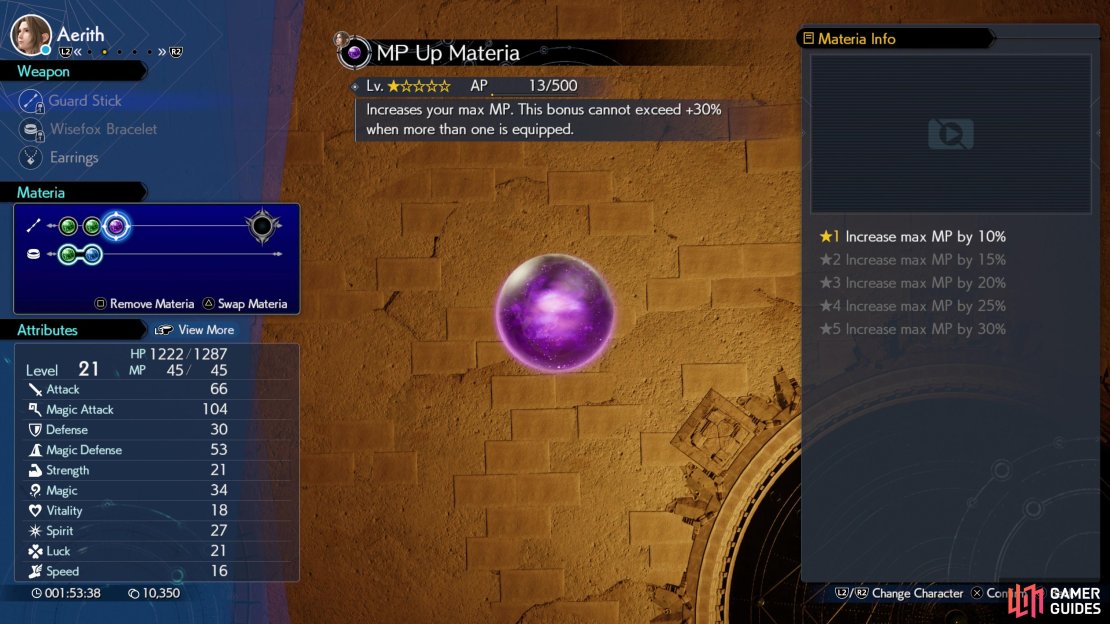Materia may just be the single most important gameplay element in Final Fantasy VII, as the materia you have equipped determines what spells you can cast, what commands you can use in battle, what summons you can call upon and, to some degree, your stats. To fill these myriad roles you’ll need numerous orbs of materia, and before your adventure ends you’ll have dozens of these magical spheres to sift through, consider and equip in the best combinations to ensure success. Fortunately materia is color-coded based on its type, and while there’s a fair bit of variability between different materia of the same type, there are some shared characteristics among similarly-colored materia that are worth noting. This page will discuss all five types of materia in Final Fantasy VII Rebirth and discuss how to use them, their properties, and other useful information.
There are five types of materia in Final Fantasy VII Rebirth.
The Five Types of Materia Explained - Final Fantasy VII Rebirth¶
There are five types of materia in Final Fantasy VII Rebirth, each of which are color coded to help you at a glance and understand how it functions:
| Materia Type | Color | Equipped Effect |
|---|---|---|
| Magic | Green | Cast equipped spells |
| Command | Yellow | Use equipped commands |
| Support | Blue | Modify paired materia |
| Complete | Purple | Apply passive bonuses |
| Summon | Red | Call equipped summon |
Of course, there’s more nuance to the differences between each type of materia than conveyed by that table above, and these differences will be detailed below.
Magic materia (green) will allow you to cast various spells, namely elemental attack spells, healing spells, buffs and debuffs.
Magic Materia¶
Perhaps the most common and straight-forward materia type in the game, these green orbs will, when equipped, allow the user to cast a variety of related spells. This covers the gamut from elemental attack spells, healing spells, status recovery spells, revival spells, buff and debuff afflicting spells, and so on. Most of these spells can only be used in combat, but then again, aside from healing spells there’s no reason to use them on the field, anyways. Each orb of magic materia typically holds several spells, more of which will become accessible as the materia levels up. Often the spells that unlock are grades of related magic; Fire, Fira, Firaga being fire elemental attack spells you can gain access to via Fire Materia, from weakest to strongest, for example. Casting spells consumes ATB and MP, and are accessed via the “Spells” command in combat.
Simply put, pretty much every fantasy caster trope you can think of is governed by magic materia, and without it you’ll largely be relegated to using physical attacks and items to achieve the myriad functions otherwise accomplished via magic materia.
(1 of 2) Command materia (yellow) will give you access to new commands you can use in combat.
Command materia (yellow) will give you access to new commands you can use in combat. (left), The Steal Materia will allow you to use the steal command, for example. (right)
Command Materia¶
As the name implies, command materia (yellow) adds new commands to your menu in combat. These can be found under the “Abilities” tab (alongside any innate abilities or [Weapon Abilities] each character may have learned), and while they consume ATB when used, they may not consume MP. The types of commands you’ll get access to via command materia are quite diverse, which is a nice way of saying they’re not really related in any way save for their core mechanics - essentially, if it was a job skill in a previous Final Fantasy game that’s not a spell, it’s the purview of command materia in Final Fantasy VII Rebirth. In Final Fantasy VII Remake examples of command materia included Chakra (self-heal), Assess (reveal enemy stats), Prayer (party heal), Steal (steal items from enemies), ATB Boost (temporarily increase ATB accumulation), Enemy Skill (use skills learned from enemies).
Some command materia can prove to be invaluable, if a bit circumstantial or conditional - being able to use Assess to see enemy weak points or Steal to grab rare items are obvious boons, while Enemy Skill materia can, depending on [what enemy skills you can learn], add a variety of abilities to a character’s arsenal.
(1 of 2) Support materia (blue) has to be equipped alongside another materia in a linked socket,
Support materia (blue) has to be equipped alongside another materia in a linked socket, (left), but once it’s paired up with another materia it will modify its effects in some way - for example, Magnify Materia will expand the paired materia’s effect to all applicable targets. (right)
Support Materia¶
Support materia (blue) is an outlier in the fact that it’s the only materia that is qualitatively useless on its own, and the only materia that fundamentally requires linked materia sockets to function. Instead of providing any effects on its own, support materia produces various effects based on what other materia it’s paired with in a linked socket. Often it modifies or enhances the paired materia’s effects, but sometimes it uses said paired materia as a template to provide other benefits.
Perhaps the most generic example of support materia is the Magnifty Materia, a type of support materia which, when paired with magic materia, will extend the effects of said magic materia to all applicable targets. Pair a Fire Materia with a Magnify Materia and your fire spells will hit all enemies, pair it with Healing Materia and you’ll heal all allies, etc. Synergy Materia, on the other hand, will cause a companion to cast spells from a linked materia when you cast an offensive spell. As yet another example, the aptly named Level Boost Materia will increase the effective level of linked materia by one, allowing you to cast spells or enjoy greater benefits that you otherwise wouldn’t yet have access to.
As you can see, support materia modifies other materia in various ways, from improving the potency of other materia, setting up combos, or automating some of the actions of your companions being prime examples. While the blue coloration gives you a good idea how you’ll need to equip it, reading the description of each orb of support materia you find is necessary to really understand how it functions and what you should pair it with.
Complete materia (purple) is a loose collection of stat-buffing materia, companion automation materia, and materia that modifys core gameplay mechanics.
Complete Materia¶
The oddly named complete materia (purple) perhaps makes more sense if you think of it as “passive” materia. Most of this materia does what it says on the tin and doesn’t require you to equip it in any specific configuration - as long as it’s equipped you’ll get some passive bonus or another, usually to some stats. HP Up, MP Up, Magic Up are all fairly straight-forward, boosting the stats they’re named after, while First Strike Materia causes you to start combat with your ATB bar partially filled (useful for quickly clearing trash mobs). Some complete materia isn’t quite as passive, however, while some trigger extra effects during or following combat actions, like Deadly Dodge Materia or Steadfast Block Materia, or even causing companions to auto-cast spells provided they’re not being controlled by the player (Auto-Cure Materia, for example).
All in all, it’s an odd category that includes passive stat-boosting materia, materia that enhances and/or alters core combat maneuvers (making it almost analogous to command materia) and materia that automates companion spellcasting (similar to support materia, albeit without linked materia).
Summon materia (red) is unreliable, but it takes up an exclusive materia socket, so there’s no harm in keeping one equipped on each character.
Summon Materia¶
The black sheep of materia, summon materia allows you to call forth powerful entities to assist you in combat, when they can be bothered to show up. When equipped, a summon gauge will fill during combat, and if it fills completely you’ll be able to use your summon materia. This costs no MP, but it takes a while for your summon gauge to fill, so you probably won’t be spamming summons during most fights. In fact, in Final Fantasy VII Remake your summon gauge filled with suspicious regularity during specific fights (or even stages of fights) to the point where, well, they were more optional, scripted events than spontaneous strategies you could employ. Once summoned, your conjured companion will only remain in combat a short while, but you can expend your own ATB bars to command them to perform powerful, unique attacks, and once their summon gauge depletes they’ll perform their signature attack before dispersing, so at the very least most summons are guaranteed heavy damage, even if they’re generally unreliable.
Given all the conditions surrounding summons, you may wonder if they’re even worth equipping. Surely you should save your precious materia sockets for more reliable materia? Well, this is yet another way in which summon materia differs; they fill a unique materia socket on the far right of each weapon. There’s only one per weapon, only summon materia can be equipped in this socket, and only one summon materia can be equipped per character at one time. That being the case, your summon materia might not be the most trustworthy of options, but it doesn’t cost you anything to keep one equipped on each character. If you get the chance to use one, great. If not, you lost nothing.
Unlike other materia, summon materia generally doesn’t level up, but they do grant stat boosts for just equipping them.












No Comments